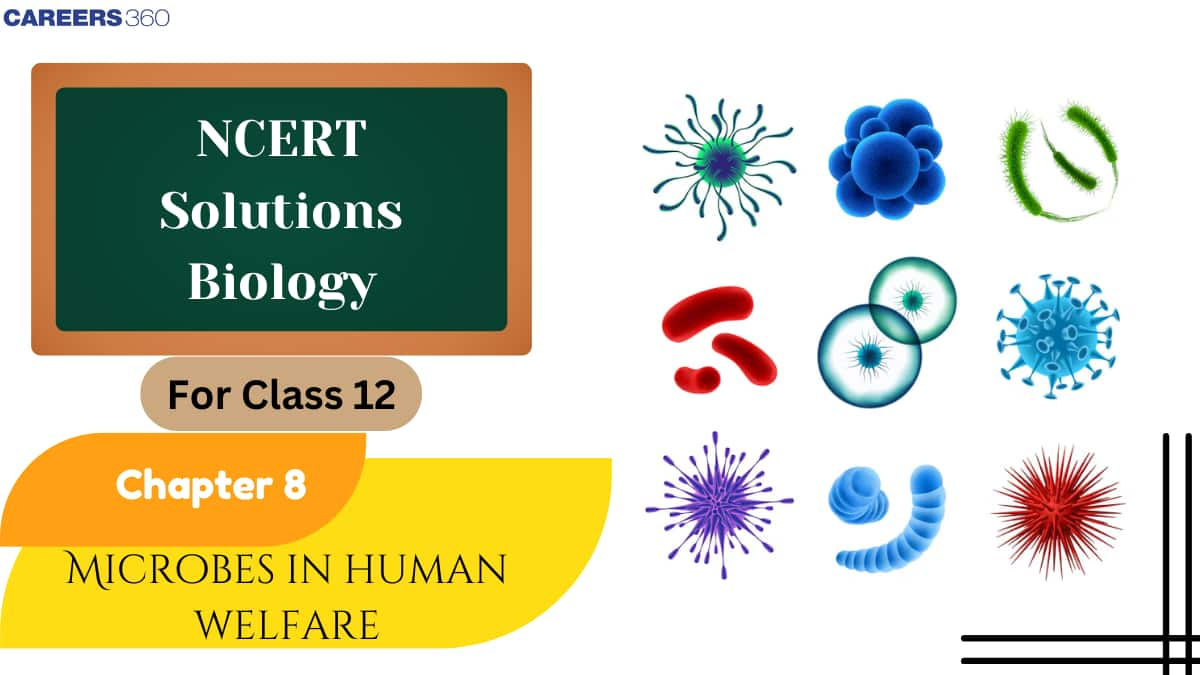Aakash Repeater Courses
Take Aakash iACST and get instant scholarship on coaching programs.
The NCERT Solutions for Class 12 Biology Chapter 8 Microbes in Human Welfare explains the importance of microbes. Microorganisms, as the name indicates, are organisms that are not seen with the naked eye. These organisms are present everywhere in soil, water, air, and food items. Microbes play a very important role in the production of valuable medicines like penicillin. All the explanations included in the NCERT Solutions are provided by subject experts in a simple manner. This makes the learning more effective and enjoyable.

Through the regular practice of the Class 12 Biology Chapter 8 Solutions, students can gain knowledge about microbes. This chapter makes them understand that although there are some harmful microbes, most microbes play a positive role. Microorganisms also help in the production of food products like bread, cheese, etc. With the use of NCERT Solutions Class 12 Biology, students can improve their performance in theory and practical questions. For quick revision, they can also download the Microbes in Human Welfare NCERT PDF.
Also Read,
NCERT Exemplar For Class 12 Biology: Microbes in Human Welfare
Students can download the PDF of the Microbes in Human Welfare chapter from the link given below. This PDF can be used offline for revision and to score well in exams.
Given below are the solved exercise questions of the Microbes in Human Welfare chapter. Practising the Class 12 Biology Chapter 8 question answer help students answer the questions effectively.
Answer:
To demonstrate the presence of microbes with the help of a microscope, the best sample we can carry is curd. Curd contains lactic acid bacteria(LAB), such as Lactobacillus, and is safe. A small portion of curd contains millions of bacteria, which can easily be observed under the microscope.
Q2. Give examples to prove that microbes release gases during metabolism.
Answer:
There are many examples where we find that microbes release gases during metabolism:
The dough that is used for making foods such as dosa and idlis is fermented by bacteria. The puffed appearance of dough is due to the production of CO2 gas.
The dough that is used for making bread is fermented by using baker’s yeast(Saccharomyces cerevisiae).
Take Aakash iACST and get instant scholarship on coaching programs.
The large holes in Swiss cheese are due to the production of a large amount of CO2 by the bacteria.
Q3. In which food would you find lactic acid bacteria? Mention some of their useful applications.
Answer:
Lactic acid bacteria grow in milk and convert it to curd. Besides this, there are other applications of lactic acid bacteria given below:
It improves the nutritional quality of curd by increasing the amount of vitamin B12.
In our stomachs, too, the LAB plays a very beneficial role in checking disease-causing microbes.
Answer:
Traditional Indian foods made of wheat, rice, and Bengal gram are:-
Wheat- Bread, Bathura, and cake are prepared from wheat
Rice - Dosa and idlis involve the use of microbes.
Bengal gram- Dhokla and khandvi are made from the Bengal gram
Q5. In which way have microbes played a major role in controlling diseases caused by harmful bacteria?
Answer:
Microorganisms have several characteristics that make them ideal organisms for the production of various products, including medicines, vaccines, and antibiotics that help in controlling diseases caused by harmful bacteria, which are given below:
Many medicines like Ergot, Cyclosporin A, and Statins are produced from the fungus and bacteria, which are used to induce uterine contractions, immunosuppressive agents, and blood cholesterol-lowering agents, respectively.
Penicillin, Cephalosporins, Streptomycin, Erythromycin, etc. Antibiotics are prepared from microbes for the treatment of diseases like pneumonia, cough, diphtheria, leprosy, etc.
Inactivated strains of microbes are used for producing vaccines.
Q6. Name any two species of fungus that are used in the production of antibiotics.
Answer:
Microorganisms possess several characteristics and are used in various fields, one of which is the important field where microbes are used in the production of antibiotics. Two species of fungus which are used in the production of antibiotics are:-
1) Penicillin - It's the first antibiotic to be discovered from the fungus Penicillium notatum.
2) Cephalosporins - These are derived from the fungus source Cephalosporium acremonium, having relieving activity against typhoid.
Q7. What is sewage? In which way can sewage be harmful to us?
Answer:
Large quantities of wastewater are generated every day in cities. A major component of this wastewater is human excreta. This municipal wastewater is called sewage. It contains a large amount of organic matter and microbes.
Hence, proper sewage disposal is of prime importance; otherwise, untreated sewage, if disposed of in water bodies, results in waterborne diseases such as malaria and dengue and also causes depletion of dissolved oxygen in the water.
Q8. What is the key difference between primary and secondary sewage treatment?
Answer:
The differences between the primary and secondary treatment of sewage are as follows:
Primary sewage treatment | Secondary sewage treatment |
Primary sewage treatment involves the physical removal of particles, large and small. | In this process, wastewater is poured into large tanks and useful aerobic microbes are allowed to grow. |
It can be done through sedimentation and filtration. | Microbes consume a large part of the organic matter and thus reduce its BOD. |
Q9. Do you think microbes can also be used as a source of energy? If yes, how?
Answer:
Several microbes have been found helpful in the solution of energy crises. Synthetic fuels are produced by the activity of microbes, including ethanol, methane, hydrogen, and hydrocarbons
Gasohol- Gasohol is a mixture of 90% gasoline and 10% alcohol and is used in several countries to combat the energy shortage.
Production of Biogas- Biogas is a mixture of gases containing mainly methane produced by microbial activity. Livestock waste is used for the generation of biogas through microbial fermentation.
Hydrogen is a valuable fuel; several algae have the capability of producing hydrogen from water in sunlight.
Answer:
Chemical fertilizers and pesticides are made up of a few minerals, thus making the soil toxic and also exploiting its nutrients. To overcome these problems, the use of biofertilizers is being encouraged. Biofertilizers are organisms that enrich the nutrient quality of the soil. They promote growth by increasing the supply or availability of primary nutrients to the plant. They mostly include nitrogen-fixing microorganisms. Some of them are given below:
Legume-Rhizobium symbiosis- Certain nitrogen-fixing bacteria, for example, rhizobium, live in symbiosis where the legume provides carbohydrates to the bacteria. Rhizobium not only increases the production of crops but also leaves a fair amount of nitrogen in the soil, which benefits the crop.
Another example of this type of symbiosis is the Azolla-Anabaena symbiosis. Apart from them, Azotobacter and Azospirillum are free-living bacteria that fix nitrogen and make it available for crop plants.
Answer:
Biological oxygen demand(BOD) is a measure of the organic matter present in the water. The greater the BOD of wastewater, the more its polluting potential.
Label | BOD Value | Sample |
A | 20 mg/L | Secondary effluent discharge from a sewage treatment plant |
B | 8 mg/L | River Water |
C | 400 mg/L | Untreated Sewage water |
Answer:
Cyclosporin A is produced by the fungus Trichoderma polysporum, which is an immunosuppressive drug, and statins from the yeast Monascus purpureus, which are blood cholesterol-lowering agents.
Q13. Find out the role of microbes in the following
Answer:
Single-cell protein
SCP is a protein-rich biomass produced from microbes. It is used as a food supplement for both humans and animals.
Microbes like algae, bacteria, fungi, and yeast are used
These microbes grow fast and contain a high amount of protein
It can be grown on waste, so it also helps in waste management
Does not depend on the climate, so production is easy and cheap
Used in animal feed and also as a protein source for people
Q13. Find out the role of microbes in the following
b) Soil
Answer:
Soil
The microbes present in the soil increase the fertility of the soil by decomposing organic matter.
The bacteria Rhizobium live symbiotically in the nodules of the roots of leguminous plants, fixing atmospheric nitrogen into organic forms, which is used by the plant as a nutrient.
Similarly, some free-living bacteria in the soil, like Azospirillum and Azotobacter) fix atmospheric nitrogen, thus enriching the nitrogen content of the soil.
Biogas, Citric acid, Penicillin, and Curd
Answer:
Penicillin: Penicillin is the first antibiotic to be discovered, an effective antibiotic to treat deadly diseases
Biogas: a mixture of gases (mainly containing methane) produced by the microbial activity on excreta (dung) of cattle, an eco-friendly source of energy, particularly in rural areas.
Curd: a portion of nutritious and easily digestible food for all age groups obtained from milk by the action of lactic acid bacteria (LAB).
Citric acid: synthetically produced by microbial transformations and used mainly as a preservative of food items.
Q15. How do biofertilisers enrich the fertility of the soil?
Answer:
Biofertilizers are organisms that enhance the nutrient quality of the soil. The main sources of biofertilizers are bacteria, fungi, and cyanobacteria.
Rhizobia bacteria live in a symbiotic association on the roots of leguminous plants. These bacteria fix atmospheric nitrogen into organic forms, which are used by the plant as a nutrient.
Other bacteria like Azospirillum and Azotobacter can also fix atmospheric nitrogen while free-living in the soil, thus enriching the nitrogen content of the soil and improving its quality.
Cyanobacteria (e.g., Anabaena, Nostoc, etc.) can also fix atmospheric nitrogen. In paddy fields, cyanobacteria add organic matter to the soil and increase its fertility.
NCERT Solutions for Class 12- Subject-wise
Microbes play an important role in human welfare by contributing to food production, medicine, agriculture, etc. Understanding their uses helps in solving questions related to this topic.
Recognise how microbes are used in household products, industries, agriculture, and sewage treatment. Students can use the NCERT Solutions for Class 12 Biology Chapter 8 Microbes in Human Welfare to understand clearly.
Recall microbes such as Lactobacillus for curd, yeast for bread, and Rhizobium for nitrogen fixation.
Linked microbes with their uses, such as biofertilizers, biocontrol agents, and the synthesis of antibiotics.
Use simple definitions for terms such as biofertilizers, biogas, and single-cell protein. These are well-explained in the Microbes in Human Welfare NCERT PDF.
Also, check the NCERT Books and the NCERT Syllabus here:
Microorganisms are tiny organisms that are present everywhere. Given below is a question from this chapter along with the answer. To gain clarity, students should practice more questions given in Microbes in Human Welfare Class 12 NCERT Solutions.
Question: Which of the following microbes is used for the commercial production of citric acid?
a) Lactobacillus
b) Aspergillus niger
c) Penicillium notatum
d) Rhizobium
Answer: The correct answer is option (b) Aspergillus niger
Explanation:
Aspergillus niger is a fungus widely used in industry to produce citric acid through fermentation. It efficiently converts sugars into citric acid under controlled conditions. This citric acid is then used in food, beverages, pharmaceuticals, and cleaning products due to its preservative and flavouring properties.
NCERT Exemplar Class 12 Solutions
Here is a table for all the topics students study beyond the NCERT for the NEET exam. Along with this, to score well, students can refer to the Microbes in Human Welfare Class 12 NCERT Solutions.
Topics | NCERT | NEET |
✅ | ✅ | |
✅ | ✅ | |
✅ | ✅ | |
✅ | ✅ | |
✅ | ✅ | |
✅ | ✅ | |
✅ | ✅ | |
✅ | ✅ |
Here is the complete chapter-wise table provided for easy access:
The Important topics of NCERT Solutions for Class 12 Biology Chapter 8 Microbes in Human Welfare are:
Microbes in the dairy industry
Microbes as food
Microbes in industrial production
Microbes in sewage production
Microbes as biocontrol agents
Microbes as Biofertilizers
Microbes, despite their small size, are of immense importance to man. They are the source of food and medicines and dispose of our wastes. This is well-explained in NCERT Solutions for Class 12 Biology Chapter 8 Microbes in Human Welfare.
Microbes play an important role in the treatment and recycling of sewage and organic and municipal wastes. Microbes like algae release oxygen and synthesize the bacterial degradation products. Students can take reference from the Class 12 Biology Chapter 8 question answer to understand the use of microbes clearly.
Microbes are ideal organisms for industrial processes. Products obtained from microbes are:-
Medicines
Organic acids
Enzymes
Alcohol
Students can find the NCERT Solutions for class 12 Biology Chapter 8 PDF through the Careers360 page, which is
https://school.careers360.com/ncert/ncert-solutions-class-12-biology
Application Date:24 July,2025 - 23 August,2025
Application Date:24 July,2025 - 23 August,2025
Changing from the CBSE board to the Odisha CHSE in Class 12 is generally difficult and often not ideal due to differences in syllabi and examination structures. Most boards, including Odisha CHSE , do not recommend switching in the final year of schooling. It is crucial to consult both CBSE and Odisha CHSE authorities for specific policies, but making such a change earlier is advisable to prevent academic complications.
Hello there! Thanks for reaching out to us at Careers360.
Ah, you're looking for CBSE quarterly question papers for mathematics, right? Those can be super helpful for exam prep.
Unfortunately, CBSE doesn't officially release quarterly papers - they mainly put out sample papers and previous years' board exam papers. But don't worry, there are still some good options to help you practice!
Have you checked out the CBSE sample papers on their official website? Those are usually pretty close to the actual exam format. You could also look into previous years' board exam papers - they're great for getting a feel for the types of questions that might come up.
If you're after more practice material, some textbook publishers release their own mock papers which can be useful too.
Let me know if you need any other tips for your math prep. Good luck with your studies!
It's understandable to feel disheartened after facing a compartment exam, especially when you've invested significant effort. However, it's important to remember that setbacks are a part of life, and they can be opportunities for growth.
Possible steps:
Re-evaluate Your Study Strategies:
Consider Professional Help:
Explore Alternative Options:
Focus on NEET 2025 Preparation:
Seek Support:
Remember: This is a temporary setback. With the right approach and perseverance, you can overcome this challenge and achieve your goals.
I hope this information helps you.
Hi,
Qualifications:
Age: As of the last registration date, you must be between the ages of 16 and 40.
Qualification: You must have graduated from an accredited board or at least passed the tenth grade. Higher qualifications are also accepted, such as a diploma, postgraduate degree, graduation, or 11th or 12th grade.
How to Apply:
Get the Medhavi app by visiting the Google Play Store.
Register: In the app, create an account.
Examine Notification: Examine the comprehensive notification on the scholarship examination.
Sign up to Take the Test: Finish the app's registration process.
Examine: The Medhavi app allows you to take the exam from the comfort of your home.
Get Results: In just two days, the results are made public.
Verification of Documents: Provide the required paperwork and bank account information for validation.
Get Scholarship: Following a successful verification process, the scholarship will be given. You need to have at least passed the 10th grade/matriculation scholarship amount will be transferred directly to your bank account.
Scholarship Details:
Type A: For candidates scoring 60% or above in the exam.
Type B: For candidates scoring between 50% and 60%.
Type C: For candidates scoring between 40% and 50%.
Cash Scholarship:
Scholarships can range from Rs. 2,000 to Rs. 18,000 per month, depending on the marks obtained and the type of scholarship exam (SAKSHAM, SWABHIMAN, SAMADHAN, etc.).
Since you already have a 12th grade qualification with 84%, you meet the qualification criteria and are eligible to apply for the Medhavi Scholarship exam. Make sure to prepare well for the exam to maximize your chances of receiving a higher scholarship.
Hope you find this useful!
hello mahima,
If you have uploaded screenshot of your 12th board result taken from CBSE official website,there won,t be a problem with that.If the screenshot that you have uploaded is clear and legible. It should display your name, roll number, marks obtained, and any other relevant details in a readable forma.ALSO, the screenshot clearly show it is from the official CBSE results portal.
hope this helps.

Take Aakash iACST and get instant scholarship on coaching programs.

This ebook serves as a valuable study guide for NEET 2025 exam.

This e-book offers NEET PYQ and serves as an indispensable NEET study material.

As per latest syllabus. Physics formulas, equations, & laws of class 11 & 12th chapters
As per latest syllabus. Chemistry formulas, equations, & laws of class 11 & 12th chapters
As per latest 2024 syllabus. Study 40% syllabus and score upto 100% marks in JEE